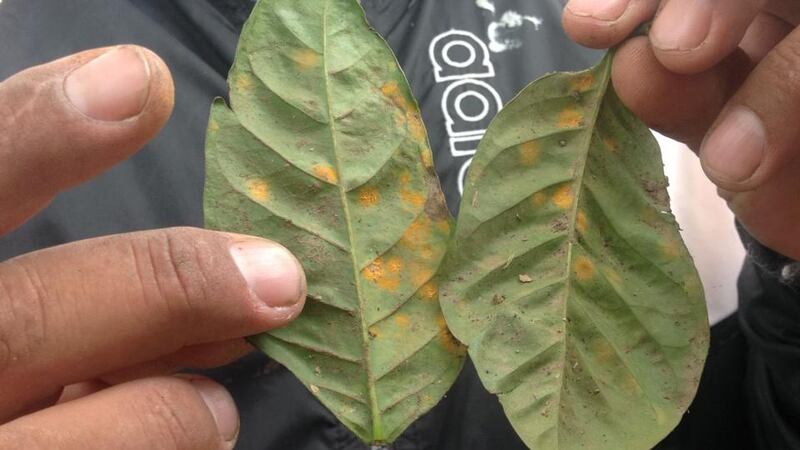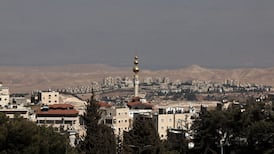It is more than 25 years since the first Irish volunteers came to Nicaragua to help pick the coffee crop. The revolution and subsequent war with the Contras is well and truly over, but Nicaragua’s coffee industry still faces serious challenges – ones that can have dire consequences when a country is as reliant on one crop as is Nicaragua. Coffee accounts for almost half of its exports.
The nature of these problems is described on a small farm in the northern region of Jinotega, which produces about two-thirds of the country’s coffee. Farmer Yamil Portillo tugs a coffee leaf from a tree and turns it over, revealing coppery spots on the underside.
In a few weeks, the spots will turn brown, causing the leaves to fall off and killing the plant. This is leaf rust, or la roya, rampant in Central America this year and the biggest threat to Nicaragua's coffee crop now.

For Europe’s discerning coffee drinkers, the disease could affect the quality of coffee in their daily latte or espresso. Nicaragua is one of the world’s biggest producers of the prized Arabica coffee favoured by Irish company Bewley’s and international chains such as Starbucks.
Asked about eradicating the disease, Portillo shrugs glumly; once leaf rust gets a grip, it’s difficult to wipe out. The only solution is to replace the coffee trees.
Latest estimates are that coffee production could be halved by the disease in Nicaragua and the worst-affected of the other countries in this region, El Salvador, Honduras and Guatemala.
The fungus has pushed higher into the hills than ever before, thanks to more rainfall and higher humidity caused by climate change. Mausi Kuhl, who owns the organic coffee farm and resort of Selva Negra near the town of Matagalpa, says the disease will seriously deter coffee production.
She says: “We usually have just a percentage of coffee plants to replace annually. Now we have to replace almost all.”
Each new plant takes three years to fruit, so Nicaraguan coffee farmers face a long slog out of this crisis.
Poor management
Kieran Durnien of Fairtrade Ireland says the leaf rust outbreak has highlighted other issues in the coffee sector in Nicaragua, such as the poor technical management of farms by their owners and the lack of finance to improve farms so they are not quite so vulnerable to disease.
In this sense, he says, it has been a blessing in disguise. “Farmers have been obliged to look at ways of better managing their plantations and the banking sector has been forced to look at ways of supporting the coffee industry again, given its importance in Nicaragua.”
These are not the only issues for coffee farmers here. The hills of northern Nicaragua may have the perfect climate and soil to grow coffee, but the terrain is difficult to negotiate, meaning transport and harvesting are tricky.
The 30km drive from Jinotega to Portillo’s farm takes over two hours by jeep on a rough track. Every so often we pass a truck, piled implausibly high with coffee pickers. The route is strung with small farms on both sides, where coffee bushes are grown in the shade of banana and cocoa trees. It is striking to see how hard coffee growers have to work to get their crops picked, processed and brought to market.
Portillo is one of the lucky ones. He and 650 other farmers, one-third of whom are women, already have support in overcoming some of their natural disadvantages, through their involvement in local cooperative, Soppexcca.
The co-op, which produces about 850 tonnes of coffee annually, is Fairtrade-certified, which means each farmer receives a minimum agreed price for every pound of coffee produced, in exchange for adhering to certain environmental and production standards. Happily, this means observing high standards of coffee husbandry and management.
Soppexcca is already engaged in an extensive coffee tree replanting programme to help combat leaf rust. In the wider development role it has carved out in these communities, it has a range of programmes aimed at improving education for young people and opportunities for women.
With finance coming from NGOs, including Irish Aid, Soppexcca is one of the few cooperatives to thrive in the years since the Sandinista government was voted out of power in 1990. It’s also a major supplier to Bewley’s, which now sources 15 per cent, or $1.6 million (€1.17 million) worth, of its coffee from Nicaragua.
Kuhl says Soppexcca is a good model for other cooperatives. “They have a good organisation. They are thinking ahead and using help wisely,” she says. It’s a surprise to learn that the route we have taken to Portillo’s farm is part of a “coffee trail” being cultivated to capture tourist dollars. At the hamlet of La Paz del Tuma, farmers bring their picked coffee to the Soppexcca “wet” processing plant, where the red fruit is cleaned, pulped and dried, before it moves to the next stage, when the bean or seed is removed and processed.
Coffee trails
At La Paz, 10 dorm rooms have recently been added to its warehouse space to support the coffee trail initiative. It’s too early yet to say whether this rudimentary accommodation will attract tourists in the same way that coffee trails have done in neighbouring Costa Rica.
As a thriving successful co-op, Soppexcca is the exception. Dave Thomson, who has worked closely with the coffee industry in Nicaragua for 30 years, says one of the reasons so many co-ops failed was that there had been no history of cooperatives in Nicaragua. This was not a movement that grew from the ground up. “Cooperatives were formed in the 1980s by name only, under the Sandinista regime, not by structure or belief. Directly or indirectly they were state-controlled,” he says.
With the Sandinistas in power, from 1979 to 1990, cooperatives were well supported and were able to avail of loans on soft terms, says Thomson. But when the Sandinista party, the FSLN, lost power, the system they had put in place began to unravel. Landowners returned to claim lands seized and redistributed or run by the Sandinistas. Loans were called in.
Women’s co-ops
Between 1993 and 2001, almost half of Nicaragua’s co-operatives failed. Kuhl says: “The co-ops that survived best were the women’s co-ops. They had more strength and cohesion. Others were a mess because they were corrupt.”
Outside the town of Sebaco, the next stage of the coffee process is well under way. Soppexcca’s large plant sits proud of an ocean of drying beans, spread out in single layers on plastic in the surrounding fields and being endlessly turned and raked by white-booted workers.
Inside, up to 100 women work the conveyor belt, picking out bad beans. All of this processing means that the coffee can be brought to a later stage of production before it is sold on, commanding a higher price for the farmers concerned.
But additional processing has a price. Bewley’s procurement director Paul O’Toole sees rapidly rising labour costs as one of the biggest challenges facing the coffee industry in Nicaragua now.
Employment levels and wages in the coffee industry have improved, but road system has not. “Infrastructure needs to be improved in the coffee growing regions, maintaining the quality which keeps Nicaragua as a unique and sought-after Arabica,” says O’Toole. This series was supported by the Simon Cumbers Media Fund.











